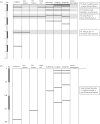The ecology of social transitions in human evolution
- PMID: 19805433
- PMCID: PMC2781881
- DOI: 10.1098/rstb.2009.0136
The ecology of social transitions in human evolution
Abstract
We know that there are fundamental differences between humans and living apes, and also between living humans and their extinct relatives. It is also probably the case that the most significant and divergent of these differences relate to our social behaviour and its underlying cognition, as much as to fundamental differences in physiology, biochemistry or anatomy. In this paper, we first attempt to demarcate what are the principal differences between human and other societies in terms of social structure, organization and relationships, so that we can identify what derived features require explanation. We then consider the evidence of the archaeological and fossil record, to determine the most probable context in time and taxonomy, of these evolutionary trends. Finally, we attempt to link five major transitional points in hominin evolution to the selective context in which they occurred, and to use the principles of behavioural ecology to understand their ecological basis. Critical changes in human social organization relate to the development of a larger scale of fission and fusion; the development of a greater degree of nested substructures within the human community; and the development of intercommunity networks. The underlying model that we develop is that the evolution of 'human society' is underpinned by ecological factors, but these are influenced as much by technological and behavioural innovations as external environmental change.
Figures





References
-
- Aiello L. C., Wheeler P.1995The expensive tissue hypothesis. Curr. Anthropol. 36, 199–222 (doi:10.1086/204350) - DOI
-
- Allen E. E.1976Against sociobiology. New York Review of Books, 182
-
- Atkinson Q. D., Gray R. D., Drummond A. J.2008mtDNA variation predicts population size in humans and reveals a major southern Asian chapter in human prehistory. Mol. Biol. Evol. 25, 468–474 (doi:10.1093/molbev/msm277) - DOI - PubMed
-
- Boback S. M., Cox C. L., Ott B. D., Carmody R., Wrangham R. W., Secor S. M.2007Cooking and grinding reduces the cost of meat digestion. Comp. Biochem. Physiol. A Mol. Integr. Physiol 148, 651–656 (doi:10.1016/j.cbpa.2007.08.014) - DOI - PubMed
-
- Bobe R., Behrensmeyer A. K.2004The expansion of grassland ecosystems in Africa in relation to mammalian evolution and the origin of the genus Homo. Palaeogeogr. Palaeoclimatol. Palaeoecol. 207, 399–420 (doi:10.1016/S0031-0182(04)00049-5) - DOI
Publication types
MeSH terms
LinkOut - more resources
Full Text Sources

